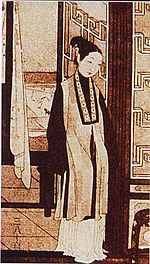

| Bijia | |||||||
|---|---|---|---|---|---|---|---|

A woman wearing a Ming dynasty bijia.
| |||||||
| Chinese | 比甲 | ||||||
| |||||||
Bijia (Chinese: 比甲) is a long, sleeveless jacket of Mongol origins which has opened side slits.[1]: 46, 68 The bijia started to be worn in the Yuan dynasty when it was designed by Empress Chabi.[2] The bijia eventually became one of the most typical form of women's clothing item in the Ming dynasty[3] and in the Qing dynasty.[4] It is also a type of hanfu which has been revived in present days.[5]
The bijia originated from a long-length Mongol vest.[1]: 46 [6] According to the Yuan shi, the invention of bijiia is attributed to Empress Chabi during the Yuan dynasty.[2][7] Empress Chabi designed the bijia so that it would be a convenient form of attire while riding horses and shooting arrows.[2] The front region of the bijia designed by Empress Chabi was made of 1-piece of fabric, and its back region was twice longer than the front region.[2][7][8] It was collarless and sleeveless, and there were two loop straps which attached to it.[2][7][8] It also had no lapels.[8] The bijia was first worn by the Yuan dynasty emperor but it later became popular among commoners.[9]
After the fall of the Yuan dynasty, Mongol fashion of the Yuan dynasty continued to influence some styles of clothing worn in the Ming dynasty; this included the persisting usage of bijia.[1]: 46 [6] The bijia became a type of women clothing in the Ming dynasty, and by the middle of the Ming dynasty it had become a favourite form of dress for women, especially young women.[9]
In the Ming dynasty, the bijia was long in length and would reach below the knee level.[3] It was embroidered on woven textile and a jade ornament would be attached at the front of the bijia as a front closure.[3] Bijia created an illusion of slenderness, which women in the Ming dynasty sought after.[3]
In the Qing dynasty, Han Chinese women were allowed to continue the Ming dynasty clothing customs.[4] The bijia remained very popular in Qing dynasty,[9] and it was one of the most common forms of female clothing worn in the 17th and 18th century.[4]
In the 21st century, the bijia regained popularity and is widely worn as a hanfu item.[10]
The Chinese opera beixin (Chinese: 背心), also known as kanjian, majia, and beida, were sleeveless vests which originated from both the Ming dynasty's long-length bijia worn by women from the lower-middle class and from the Qing dynasty's majia (Chinese: 马甲),[11] a type of vest which were worn by the Manchu.[12]
The majia (Chinese: 马甲), the sleeveless riding vest of the Qing dynasty, evolved from the bijia which was popular among women during the Ming and Qing dynasties.[9][13]
{{cite book}}: CS1 maint: location missing publisher (link)
{{cite book}}: CS1 maint: location missing publisher (link)
{{cite book}}: CS1 maint: others (link)
{{cite book}}: CS1 maint: location missing publisher (link)
|
| |||||||||||||||||||
|---|---|---|---|---|---|---|---|---|---|---|---|---|---|---|---|---|---|---|---|
| Characteristics |
| ||||||||||||||||||
| Garments |
| ||||||||||||||||||
| Headwear (list) |
| ||||||||||||||||||
| Footwear (list) |
| ||||||||||||||||||
| Accessories (list) |
| ||||||||||||||||||
| Influenced clothing |
| ||||||||||||||||||
| Cosmetics |
| ||||||||||||||||||
| |||||||||||||||||||